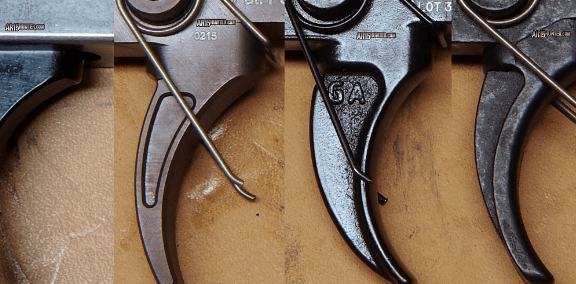The AR-15 platform is a favorite among gun enthusiasts due to its versatility and customizability. Among the many modifications available, upgrading the trigger is a popular choice. When it comes to triggers, two main types dominate the discussion: the two-stage AR trigger and the single-stage trigger. Each has its unique characteristics, advantages, and applications. This article delves into the five key differences between these two types of triggers to help you make an informed decision on which might be best for your needs.
Trigger Pull Stages
The most fundamental difference between a two-stage AR trigger and a single-stage trigger lies in the number of stages involved in the trigger pull.
Single-Stage Trigger:
A single-stage trigger offers a straightforward, continuous pull. From the moment you start pulling the trigger, it moves smoothly to the breakpoint where the shot is fired. There is no noticeable change in resistance; it’s a single, consistent motion.
Two-Stage AR Trigger:
In contrast, a two-stage AR trigger has two distinct phases in its pull. The first stage involves taking up slack with a lighter pull weight. You feel a clear stop after this initial stage. The second stage requires more pressure to break and fire the shot. This separation allows for more precise control over the shot, as the shooter can pause at the end of the first stage before deciding to take the shot.
See also: What are the Common Causes of Pedestrian Accidents in Glen Falls?
Control and Precision
The design differences in these triggers significantly affect control and precision, which is a crucial consideration depending on the intended use of the firearm.
Single-Stage Trigger:
This type of trigger is favored for applications where quick follow-up shots are necessary. Because there is no intermediate stop, the shooter can quickly fire multiple rounds with a consistent trigger pull each time. This can be advantageous in dynamic shooting sports or defensive situations where speed is critical.
Two-Stage AR Trigger:
A two-stage AR trigger provides enhanced control and precision, making it ideal for applications where accuracy is paramount. The initial stage allows the shooter to prepare for the shot and ensure proper alignment before applying the final pressure to fire. This can be particularly beneficial in precision shooting, hunting, and long-range target shooting where every fraction of a second and millimeter count.
Trigger Weight and Feel
The feel of the trigger and the weight required to pull it are critical factors that influence shooting comfort and performance.
Single-Stage Trigger:
Single-stage triggers typically have a consistent pull weight throughout the entire movement. This weight can vary widely depending on the specific trigger but generally ranges from 3 to 6 pounds. The feel is straightforward and predictable, which can be preferred by shooters who want simplicity and reliability.
Two-Stage AR Trigger:
Two-stage AR triggers have a unique feel due to their two-part pull. The first stage is usually lighter, allowing the shooter to take up the slack with minimal effort. The second stage has a heavier pull weight, which is where the shot is actually fired. This combination can result in a total pull weight that is higher than a single-stage trigger but offers a more controlled shooting experience. For instance, a two-stage trigger might have a first stage of 2 pounds and a second stage of 3 pounds, resulting in a combined pull weight of 5 pounds.
Application and Suitability
The intended use of the firearm often dictates which type of trigger is most suitable.
Single-Stage Trigger:
Single-stage triggers are commonly found in rifles used for tactical applications, home defense, and certain shooting sports such as 3-gun competitions. The immediate, no-nonsense pull is beneficial in high-stress scenarios where quick, successive shots are necessary. The simplicity and consistency also make it easier for some shooters to achieve a consistent trigger pull, which is essential in competitive settings.
Two-Stage AR Trigger:
Two-stage AR triggers shine in scenarios that demand a high level of precision and control. They are often preferred by competitive shooters in disciplines such as long-range shooting, precision rifle series (PRS), and hunting. The ability to pause after the first stage to ensure perfect sight alignment and breath control can significantly enhance accuracy. Additionally, many military and law enforcement snipers favor two-stage triggers for their precision shooting requirements.
Customization and Preferences
Customization options and personal preferences play a significant role in the choice between a two-stage AR trigger and a single-stage trigger.
Single-Stage Trigger:
Single-stage triggers are generally simpler in design, which can make them easier to install and maintain. They are often available at a lower price point compared to two-stage triggers. Many shooters prefer the straightforward nature of a single-stage trigger, particularly if they are accustomed to it or prioritize simplicity in their shooting experience.
Two-Stage AR Trigger:
Two-stage AR triggers tend to be more complex and may require more careful installation and adjustment. However, they offer a higher degree of customization, allowing shooters to fine-tune the trigger to their exact preferences. Some models allow for adjustments to the weight of each stage, the length of travel, and even the breakpoint. This level of customization can provide a more personalized shooting experience tailored to the shooter’s specific needs and preferences.
Conclusion
Ultimately, your choice between a two-stage AR trigger and a single-stage trigger depends on your shooting style, the intended use of your firearm, and personal preference.
A single-stage trigger is ideal for scenarios that demand quick, consistent shooting without the need for intermediate stops. Its simplicity and reliability make it a go-to choice for many tactical applications and shooting sports where speed is crucial.
On the other hand, a two-stage AR trigger offers enhanced control and precision, making it perfect for precision shooting, hunting, and any situation where accuracy is paramount. The distinct stages allow shooters to prepare and align their shots more meticulously, providing a significant advantage in precision-based disciplines.
Both triggers have their strengths and can dramatically impact your shooting experience. Whether you prioritize speed or precision, understanding the differences between these triggers will help you make an informed decision that aligns with your shooting goals. Ultimately, the best trigger for you is the one that feels most comfortable and meets your specific needs, enhancing your overall shooting performance.


